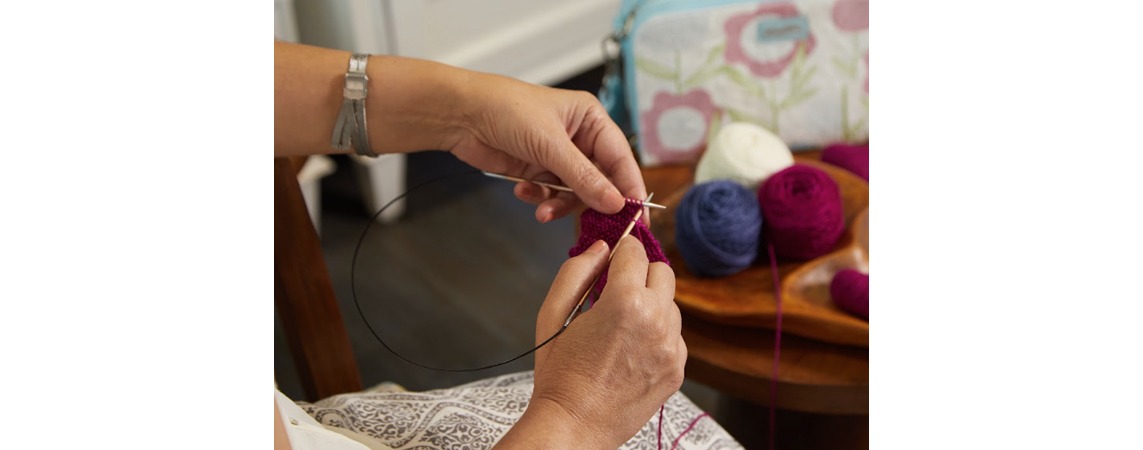Knitting decreases are techniques that every knitter must master. Decreases are essential for various knitting for that matter crochet projects too, that require shaping. There is no special requirement for knitting needles as they work with pairs of single-pointed, sets of DPNs as well as circular needles. There are many knitting decrease techniques that reduces the stitch count from the previous row or round. Among the vast range of decrease techniques in knitting, the central double decrease (CDD) stands out for its versatility. As the name suggests, this double decrease technique reduces three stitches into one. The CDD is a powerful tool in your knitting arsenal, ready to bring your projects to life. To know everything about central decrease technique, in this blog, we’ll walk you through the steps and the various ways you can utilize it in your knitting projects.
What is Central Double Decrease?
The Central Double Decrease abbreviated as CDD is a knitting technique that decreases two stitches together. There are several ways to work a double decrease depending on the effect desired. With CDDs, one stitch remains visible while the other two stitches will be partially hidden behind the dominant stitch. It centralizes the remaining stitch, creating a triangular shape. The direction of the visible stitch determines whether the decrease is left- or right-slanting or vertical. Its applications are diverse, from creating sharp, defined decreases in the center of a lace motif, the top of a hat, or triangular shawls, to shaping garments like raglan sleeves or V-necks.
Let's get started! Knit your project according to the pattern instructions till you get to the point of working on a CDD.
One step at a time: Step-by-step instructions
Step 1- Start by gently taking two stitches from your left knitting needle and moving them to the right needle. To do this, place your right needle into these two stitches and pretend as if you are going to knit them together, but here is the twist: Do not knit them! Just slide them on the right needle. This step will not produce any new stitches; it just rearranges the original ones to prepare them for the decrease. For a clear idea, explore our guide on slip stitch in knitting.
Step 2-Once you have those two stitches on your right needle, focus on the next stitch on your left needle. Knit this stitch the usual way. This knit stitch plays a very important role because it becomes the centerpiece of your decrease. It's the stitch that will remain visible after the decrease is completed.
Step 3-Now, bring back those two stitches that you slipped earlier. Using your left needle, pick them up and carefully lift them over the stitch you just knitted and off the right needle. This maneuver pulls them over and out of the way, effectively merging three stitches into one. This final step tightens your knitting and focuses the fabric into a neat, single stitch.
Tips to work on perfect CDD

- Maintain uniform tension throughout the process. If it's too tight, you'll struggle to pass the slipped stitches over; if it's too loose, the decrease won't be as sharp.
- Choose the right material and type of needle. For example, wooden or bamboo needles offer more grip, which can be helpful for beginners or when working with slippery yarn. If you love speed in your knitting then metal needles like stainless steel or aluminium will be perfect!
- It’s highly recommended to try CDD on a sample swatch first before working on a project to get comfortable and confident with the movement and result.
Now that you're good to go with the CDD, Are you ready to apply it? Here are some amazing ideas:
Lace Knitting Patterns : CDD is often used in lace knitting to create noticeable decreases that form part of the design. The CDD technique in lace patterns not only creates a beautiful aesthetic but also helps maintain the integrity of the lace structure, ensuring that the pattern remains open and airy.
Garments:Use CDD to shape garments, particularly for raglan sleeves or in the center of a V-neck. The CDD technique in garment shaping is beneficial because it creates a clean, sharp decrease that helps maintain the structure and fit of the garment.
Accesories: Hats and mittens shine when you use the Central Double Decrease (CDD), especially in areas like the crown of a hat or the thumb gussets of mittens. This technique creates neat, centered reductions that enhance the fit and finish of your projects. With the central double decrease, you'll be able to achieve a clean and sleek look in your knitting projects. Selecting the ideal knitting needles for your work and getting some practice with the technique can make a huge difference. Soon, CDD will be your favorite go-to method for knitting ventures. And remember, the real beauty of knitting lies in the small details! Techniques like the CDD will allow you to personalize your pieces, giving them a distinct touch that's uniquely yours.
Mastering decreases such as CDD requires practice. But, it also requires smooth knitting tools and accessories. KnitPro's knitting needles and sets offer a variety of sizes, tips, and cable lengths, ensuring you find the perfect fit for your project. Explore Symfonie, Dreamz, or Ginger if you prefer wood. Our metallic range Zing, Nova, or our high-tech carbon fiber range, Karbonz works for smooth crafting. For a mindful practice, we have the Mindful Collection offering stainless steel knitting needles. Along with knitting needles & sets, explore our accessories collection to assist with smooth crafting.












